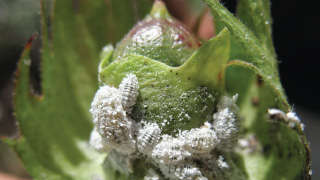
Guru GyaanAgroStar Agronomy Centre of Excellence
Integrated Management of cotton mealybug
Mealybug is not an native origin of India, it entered from the other counties. There was an outbreak in Gujarat during 2006 and later on it observed other states also. The infestation is observed every year in cotton growing year. In addition to cotton, this pest also attacking to the other crops. Nowadays, initiation of mealy bugs is observed in several pockets of cotton in India. Mealybugs suck the sap from the each and every parts of the cotton plants. Infested plants exhibit symptoms like distorted & busy shoots, crinkled and/or twisted and bunchy leaves, and stunted plants. Infested plants turns into yellowing and dried completely. It also hinder in the photosynthetic activity of the plants. Population is increased as the dry spell is extended for longer period in monsoon or as the monsoon is over, population is built up.
Integrated Management:
• Remove & destroy all alternate-unwanted plants.
• Do not throw the mealybug infested weed host plants after removing in water channel.
• Locate the ant colonies in the field and drench those burrow with Chlorpyriphos 20 EC @ 20 ml per 10 lit of water. Repeat the same 2-3 times on need base.
• Uproot severely affected cotton plants at early stage and take away from the field and destroy them.
• Wash equipments with a jet of water or spray of chemical insecticides before moving to another cotton fields.
• Aenasius bambawalei is an important parasite (40-70% parasitism) of mealybug. Avoid the toxic insecticides when this parasite is observed abundant.
• Monitor the fields regularly and give spot application of recommended insecticides to prevent further spreading of the pest.
• On initiation of the pest, spray Neem oil @ 40 ml or neem based formulation @ 10 ml (1% EC) to 40 ml (0.15% EC) per 10 lit of water.
• Spray Verticillium lecanii, fungal pathogen @ 40 g or ml per 10 litres of water during high humid days in evening time.
• If population showed increasing trend than spray Profenophos 50 EC @ 10 ml or Thiodicarb 50 WP 10 g or Buprofezin 25 SC @ 20 ml or Chlorpyriphos 20 EC @ 20 ml per 10 lit of water. Also add any detergent powder @ 10 g per 10 lit of water into the solution.
• Change the insecticides at each spray. See that, plants must be covered properly with insecticide spray.
• Do not allow sheep/ goat/ animal for grazing in the field to avoid further spreading.
Dr. T. M. Bharpoda,_x000D_
Ex. Professor of Entomology, _x000D_
B. A. College of Agriculture, Anand Agricultural University, Anand- 388 110 (Gujarat India)_x000D_
_x000D_
_x000D_
If you find this information useful, click on the yellow thumbs up sign under the photo and also share this with your farmer friends using the options given below.
537
3

